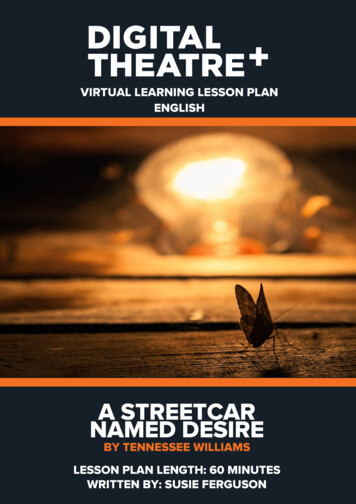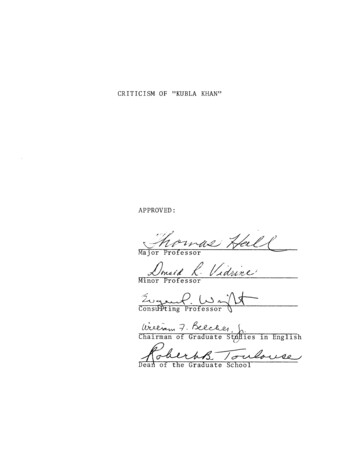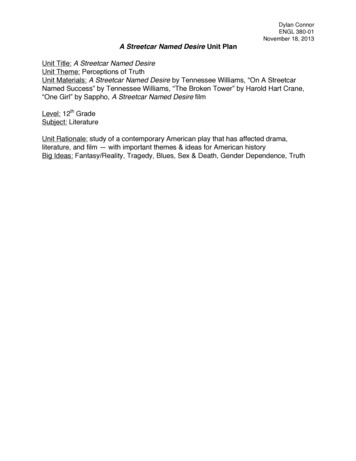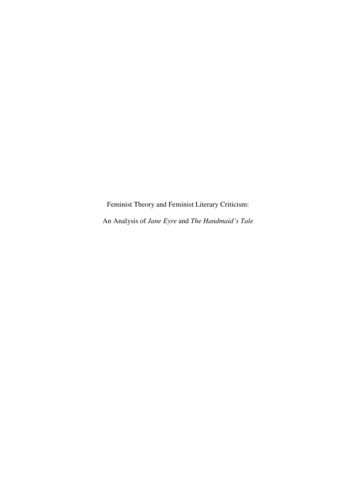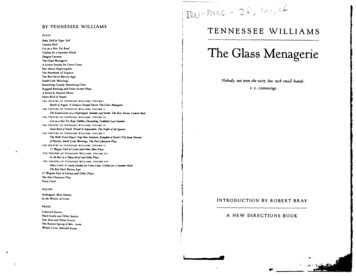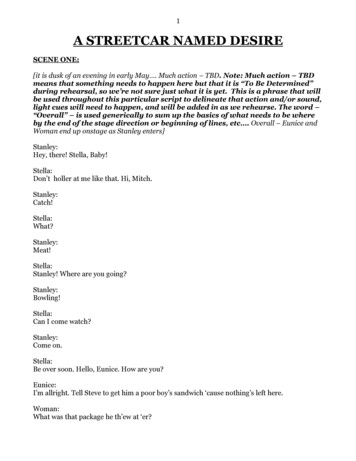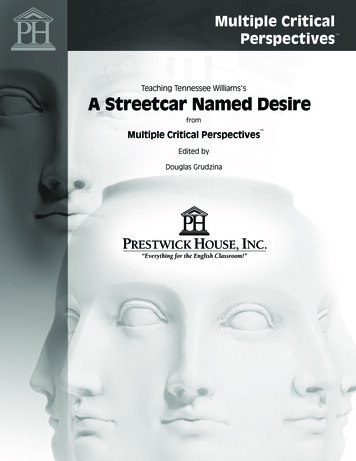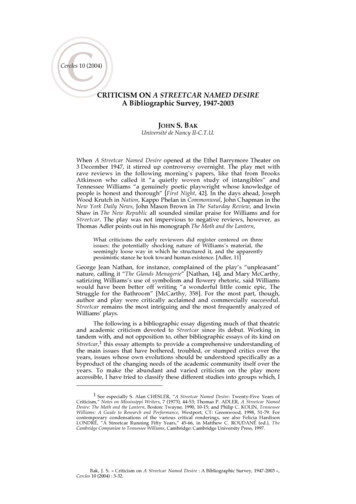
Transcription
Cercles 10 (2004)CRITICISM ON A STREETCAR NAMED DESIREA Bibliographic Survey, 1947-2003JOHN S. BAKUniversité de Nancy II-C.T.U.When A Streetcar Named Desire opened at the Ethel Barrymore Theater on3 December 1947, it stirred up controversy overnight. The play met withrave reviews in the following morning’s papers, like that from BrooksAtkinson who called it “a quietly woven study of intangibles” andTennessee Williams “a genuinely poetic playwright whose knowledge ofpeople is honest and thorough” [First Night, 42]. In the days ahead, JosephWood Krutch in Nation, Kappo Phelan in Commonweal, John Chapman in theNew York Daily News, John Mason Brown in The Saturday Review, and IrwinShaw in The New Republic all sounded similar praise for Williams and forStreetcar. The play was not impervious to negative reviews, however, asThomas Adler points out in his monograph The Moth and the Lantern,What criticisms the early reviewers did register centered on threeissues: the potentially shocking nature of Williams’s material, theseemingly loose way in which he structured it, and the apparentlypessimistic stance he took toward human existence. [Adler, 11]George Jean Nathan, for instance, complained of the play’s “unpleasant”nature, calling it “The Glands Menagerie” [Nathan, 14], and Mary McCarthy,satirizing Williams’s use of symbolism and flowery rhetoric, said Williamswould have been better off writing “a wonderful little comic epic, TheStruggle for the Bathroom” [McCarthy, 358]. For the most part, though,author and play were critically acclaimed and commercially successful.Streetcar remains the most intriguing and the most frequently analyzed ofWilliams’ plays.The following is a bibliographic essay digesting much of that theatricand academic criticism devoted to Streetcar since its debut. Working intandem with, and not opposition to, other bibliographic essays of its kind onStreetcar,1 this essay attempts to provide a comprehensive understanding ofthe main issues that have bothered, troubled, or stumped critics over theyears, issues whose own evolutions should be understood specifically as abyproduct of the changing needs of the academic community itself over theyears. To make the abundant and varied criticism on the play moreaccessible, I have tried to classify these different studies into groups which, I1 See especially S. Alan CHESLER, “A Streetcar Named Desire: Twenty-Five Years ofCriticism,” Notes on Mississippi Writers, 7 (1973), 44-53; Thomas P. ADLER, A Streetcar NamedDesire: The Moth and the Lantern, Boston: Twayne, 1990, 10-15; and Philip C. KOLIN, TennesseeWilliams: A Guide to Research and Performance, Westport, CT: Greenwood, 1998, 51-79. Forcontemporary condensations of the various critical renderings, see also Felicia HardisonLONDRÉ, “A Streetcar Running Fifty Years,” 45-66, in Matthew C. ROUDANÉ (ed.), TheCambridge Companion to Tennessee Williams, Cambridge: Cambridge University Press, 1997.Bak, J. S. « Criticism on A Streetcar Named Desire : A Bibliographic Survey, 1947-2003 »,Cercles 10 (2004) : 3-32.
Cercles 10 / 4feel, draw the essential lines of demarcation between how the play has beenvariously interpreted in the last half century. Beginning first with acomparison of the formalist social/psychological readings that interrogatethe problematic of “meaning” in the play, the essay next explores thecompeting interpretations of that resultant ambiguity, concluding with abrief survey of the recent trend to import feminist, queer, and CulturalStudies paradigms to the play’s analysis. Though most of the books andarticles cited within this essay cannot be entirely reduced to just oneparticular idea, I have tried to remain as faithful as possible to the authors’defining theses, even if those theses tend to place them in more than oneparticular camp or school of critical thought.Williams’s journeyman plays, those he wrote for the Mummers in St.Louis or for Professor E.C. Mabie at the University of Iowa in the 1930s,readily fluctuated between social agitprops, like those he had hoped wouldwin him favor with Chicago’s WPA Federal Writers’ Project, andexpressionistic dreamplays, which fed his poetic needs for a plastic theater.Because the early Williams could easily be categorized as both a socialdramatist and a Freudian one—the playwright of both Not about Nightingalesand Battle of Angels—critics who were at first confused by Streetcar’ shermeneutics sought to classify the play either as Williams’s socialcommentary on a post-FDR America (or a post-Reconstructionist one, forthat matter) or as a psychological study of a fragile mind’s struggle tonegotiate nostalgia with reality (one not too distant from his experienceswith the dementia of his sister Rose).Streetcar as Social DramaThough a substantial number of critics believe Streetcar to be essentially asocial drama, few have found themselves in concert in defining what kind ofsocial drama Williams’s play most resembles. The first school argues thatBlanche and Stanley represent archetypes of cultures or species. From thisperspective, Eric Bentley and Roger Boxill call Streetcar a “social-historicaldrama” [Bentley, 402; Boxill, 79]. Thus Stanley and Blanche’s clash is nothuman against human but rather species against species. Three branches ofthis critical school of social dramatization find Streetcar to be a textbookrepresentation of Strindbergian and Chekhovian Naturalism, of NietzscheanApollonian/Dionysian dichotomy, or of Darwinian natural selection. Asecond school, however, focuses on Blanche and Stanley as uniqueindividuals and not as types, with the audience acting as voyeurs of theirpersonal war. This school can similarly be divided into three branches: thosewho see Streetcar as a study of Lawrentian blood knowledge, of hero versusantihero, and of villain versus victim.Joseph Wood Krutch has made the claim in both The American DramaSince 1918 and “Modernism” in Modern Drama that he had heard third-handwhat Williams said about the meaning of Streetcar: “You had better look outor the apes will take over” [American Drama, 331; Modernism, 129]. Krutchfinds in this naturalistic determinism the thesis of most modern (pre-1950)American drama. He sums up half a century’s dramatic fiction thus,
John S. Bak / 5The thesis which from the very beginning I have been attempting toexpound might be summed up in such a way as to include a phrasefrom Williams’s alleged comment. That is, a break with the past asradical as that which much modern thought and much modern dramaseems to advocate unintentionally prepares the way for the apes totake over. [“Modernism,” 129-130]From this understanding, Krutch argues that Streetcar is “a sort of semisurrealist version of the Strindbergian submission to destructive obsessions”[“Modernism,” 124].Several critics have also alluded to this naturalistic struggle forcultural hegemony, though dropping the Strindberg label at times. Weeksafter the first performance, for instance, Irwin Shaw said Streetcar waswritten with “a triumphantly heightened naturalism” [Miller, 45]. Equally,John Gassner, in his landmark College English essay of 1948 “TennesseeWilliams: Dramatist of Frustration,” calls Streetcar a “naturalistic drama”[Gassner, 6]. Joan Templeton, like Thomas E. Porter, Pnina Rafailovich,Joseph K. Davis, and Durant da Ponte, also writes about the cultural clashesbetween Stanley and Blanche. Building upon W.J. Cash’s “Cavalier thesis,”Templeton argues that Blanche, through her own “epic fornications,” is justas responsible for her fall as the Old South is for its own demise. Althoughthe Strindberg label is missing in Templeton, as it is in all of these argumentshere, its essence is still present.Kenneth Bernard in Philip Kolin’s “A Streetcar Named Desire: APlaywrights’ Forum” describes an identical naturalism in Streetcar, not inStrindbergian but in Chekhovian terms. Bernard finds Streetcar, as JohnGassner did earlier in his “A Study in Ambiguity” [Bogard & Oliver, 377],similar to The Cherry Orchard. Both plays portray the decline of one cultureand the subsequent rise of another. Here, the serf Lopahin’s rise to economicpower presages Stanley Kowalski’s ascension in the New South; and inBlanche, the aristocratic but bourgeois Old South has fallen victim to thenatural evolution (some say revolution) of the rise of the proletariat. JacobH. Adler defends this Chekhovian view in his “Tennessee Williams’s South:The Culture and the Power” (revised from his earlier essay, “The Rose andthe Fox”), where he argues that all of Williams’s plays set in the South dealwith the confrontation between culture and power, though in Streetcar thatis not all that is at work,What is primary is story and people as they are, as they inevitably are;what is secondary is Blanche and the others as representative of theculture-power dichotomy and the southern dilemma; what is tertiary[ ] is Blanche as representative of the sensitive individual lost in thecomplex, impersonal modern world. [Tharpe, 40]Constance Drake, in “Blanche Dubois: A Re-Evaluation,” agrees with JacobAdler’s assessment (the Chekhovian connection) and finds Williams“presenting the pessimistic view of modern man destroying the tenderaspects of love. [ ] And, in Blanche’s refusal to submit, she is beingportrayed as the last representative of a sensitive, gentle love whose defeat isto be lamented” [Drake, 59].
Cercles 10 / 6None, though, has had as much influence on this naturalistic theory asElia Kazan, Streetcar’s first, and arguably most influential, director. From hisprivate director’s notebook, published for the first time in 1976, Kazaninforms us as to where his sympathies lay. Although he identifies withBlanche’s plight, his support is with Stanley. In his Stanislavskian reading ofStreetcar, looking for the “spine” of each character, he concludes thatStanley’s “spine” is to keep things his way, that he must fight off thedestructive intrusions of Blanche who “would wreck his home,”Blanche is dangerous. She is destructive. She would soon have himand Stella fighting. He’s got things the way he wants them aroundthere and he does not want them upset by a phony, corrupt, sick,destructive woman. This makes Stanley right! Are we going into the eraof Stanley? He may be practical and right. [ ] but what the hell does itleave us? [Cole & Chinoy, 375]Kazan’s direction heavily favored making Stanley the victim of Blanche’sonslaughts against his name, his heritage, his masculinity, and ultimately hisfamily. (Some audiences, it was reported, actually cheered during the rapescene of Kazan’s production.) It was not until Harold Clurman took over asdirector of the road version of the play that a shift to Blanche as victim tookplace, a shift which would inaugurate the timeless debate over Streetcar’smeaning. Under Clurman’s direction, Blanche and Stanley became realpersons, not representations of a moribund culture and a thrivingsocioeconomic middle class.Nevertheless, while many critics have suggested strains ofStrindbergian Naturalism in Streetcar, making specific comparisons betweenit and Miss Julie, Richard Vowles offers the most in-depth study of these twoplaywrights in his “Tennessee Williams and Strindberg.” Vowles concludesthat while there are indeed traces of Strindberg’s influence on Williams inboth of their treatments of human misery, sexual and social conflicts, andtheatrics, the number of differences between the two far outweighs anysimilarities. At best, only in his theatrics does Williams become a Strindbergstudent. Poncho Savery concurs with Vowles’s anti-naturalistic reasoning,writing that Williams cannot be labeled a naturalistic writer because “awriter of naturalism believes in scientific determinism and tends to createone-dimensional characters who are the living embodiments of naturallaws” [Savery, 4035A]. Such a writer believes in didactic morality and not, asWilliams does, in psychological realism.Thomas P. Adler in The Moth and the Lantern suggests that theStrindberg/Chekhov labels are both valid, if Streetcar is viewed from alteredperspectives. If, for instance, one were to find Stella and Stanley’srelationship as the play’s locus, then Strindberg’s Miss Julie would seemStreetcar’s literary progenitor with their similarities in a lower-class malepulling an upper-class female down from her aristocratic tower [Adler, 65].If, however, one reads Streetcar as Blanche’s struggle with Stanley, then theChekhov label would seem justifiable; for The Cherry Orchard and Streetcarare both about the proletariat supplanting the effete bourgeoisie [Adler, 39].Streetcar is, in the least, a blending of these two matrices.
John S. Bak / 7With essays like Gassner’s in College English and Harry Taylor’s “TheDilemma of Tennessee Williams” in Masses and Mainstream (both in 1948),Williams’s and Streetcar’s place in the American literary pantheon seemed injeopardy. Critics knew they had witnessed in Streetcar something dreadfulbut were not sure what was so tragic about it. Taylor intimates that thereason for this uncertainty lies in Streetcar’s immature artistry: Williamscreates opposition in Blanche and Stanley but not true tragic conflict [Taylor,54-55]. Yet it is this same opposition that other critics see as successful inStreetcar. The opposition between Blanche and Stanley is not, they argue,between cultural types, but between human types. Thus, whereas one sideargues that Williams is creating a Blakean chiaroscuro as embodied inNietzsche’s Apollonian/Dionysian personality types, the other side finds inStreetcar the simple display of Darwinian natural selection which TennesseeWilliams himself emphasizes. While the second group finds somejustification for the conflict—the survival of the family unit is at stake—theformer group sees romantic sensitivity crushed by realistic brutality, andnothing more.In his Birth of Tragedy, Nietzsche describes an archetypal strugglebetween restraint (Apollonian) and passion (Dionysian). In his analysis ofStreetcar, subtitled “Nietzsche Descending,” Joseph Riddel asserts thatWilliams borrowed from Nietzsche “in great chunks, often undigested”[Riddel, 421]. Although Williams, like many American artists who borrowedfrom European ideologies, took liberties in his philosophy, the essence is stillthere. Riddel writes,But even in Streetcar one must begin with a contradiction between hisintellectual design and the militant primitivism of the theme; or to usea philosophical gloss, one must begin with Nietzsche’s ApollonianDionysian conflict, in an almost literal sense. [Riddel, 421]The Apollonian figure is characterized by restraint and order, the Dionysianby passion and metaphysics. Nietzsche accepts the dialectic, finding a tragicbut necessary beauty to the bond. Riddel points out that Blanche isApollonian and Stanley Dionysian, but the reason Streetcar fails is becauseWilliams misinterpreted Nietzsche. By suggesting that Dionysian behavioroften dominates the Apollonian, Nietzsche did not mean that passiondefeats restraint, as Williams thought, but that order moves inevitablytoward chaos.Joseph Riddel is not the only critic to make the Nietzscheanconnection. Judith J. Thompson describes Streetcar’s mythos as a “dramaticagon” between Stanley (Dionysus) and Blanche (Pentheus), based onEuripides’ The Bacchae [38 ff.]. Britton J. Harwood in his “Tragedy as Habit:A Streetcar Named Desire” also finds the Apollonian/Dionysian dialectic inthe Blanche-Stanley conflict, but Harwood sees the struggle better describedin Rudolf Otto’s terminology: Self versus Other. Harwood sees the crux ofStreetcar as a code of loyalty both upheld and betrayed. Whereas Stellaremains loyal to Stanley by the end (as Stanley is to Mitch in protecting himfrom Blanche), Blanche betrays her loyalty to Allan by exposing hishomosexuality, just as Stanley does her promiscuity. By recognizing theWholly Other in each other, that which is “both dreadful and fascinating”
Cercles 10 / 8[Tharpe, 107], Stanley and Blanche battle in order to preserve the Self, whosedominion is in peril.Many others describe this same phenomenon, this socialconfrontation with opposing human types, though not in Nietzschean terms.Harold Clurman, for example, writes in N a t i o n that Streetcar is a“dramatization of sensibility crushed by [ ] brutishness” [Clurman, 635].And Henry Popkin traces the classical Adonis-Gargoyle myth in Williams,where the healthy young man (Stanley) is pitted against the older neuroticwoman (Blanche) [Popkin, 48]. But Signi Falk in her 1958 Modern Dramaessay, “The Profitable World of Tennessee Williams,” provides one of thebetter insights into Williams’s technique of juxtaposing character typesonstage. Falk, in short, vilifies Williams as a careerist for creating plays notwith real people but with stock characters such as the dreamer, the animal,and the Mamma’s boy for his men, and the neurotic southern belle and themother figure for his women. So, while some critics find Williams successfulin his drama of human types at odds, others, like Falk, find this form ofdrama deplorable [Falk, 180].The other group who argues for Streetcar as a dramatization of humannature types sees it as a play not of ideologies but of sexual aggression forprotection and propagation. These critics find Williams writing a play basedon Darwinian natural selection: Blanche and Stanley are two opposinganimals of the same species striving for the survival of their kind, with Stellaas the prize. Deborah Burks, for instance, calls the conflict “less [ ] astruggle between Good and Evil” and more a “Social Darwinist struggle forsurvival between two ‘species’ of human beings” [Burks, 37]. Blanche, intrying to save Stella from the bestial Vieux Carré with her “Don’t hang backwith the brutes” speech, solicits open warfare from Stanley, who must inturn destroy Blanche before she damages his and Stella’s life in the ElysianFields. As do Anca Vlasopolos and Sarah Boyd Johns [Schlueter, FeministRereadings, 158-159 & 143], Leonard Casper sees this triangle of oppositionwith Stella at the apex as Williams’s “cellular structure of a propercommunity [ ] composed of diverse elements (apposition), but withoutdivisiveness (opposition)” [Tharpe, 752]. In this community, Casperbelieves, “all men are intermediaries to one another’s missions” [Tharpe,752]. For Blanche, that mission is to revitalize an effete southern culture; forStanley, it is to assure the continued evolution of the efficient Napoleoniccode, symbolized in the birth of his son at the end of the play. Both fightover Stella, for in her choosing one species means the death of the other.Edward F. Callahan and Thomas P. Adler both describe this samescenario, though with a twist. Since Streetcar recalls a medieval dialoguebetween flesh and spirit, Callahan argues in “Tennessee Williams’s TwoWorlds,” it is a morality play, and Stella, the third member of this triptych,must choose between the two ethical values represented by Blanche (spirit)and Stanley (flesh) [Callahan, 62-63]. Adler concurs, finding Streetcar “amodern variation on the medieval morality play” [Adler, Moth, 75]. Like TheCastle of Perseverance, Adler writes, Streetcar “follows humankind from birthto death, dramatizing the conflict of the Virtues and Vices, as they strugglefor the soul of a universalized, everyman figure” [Adler, Moth, 75].
John S. Bak / 9John T. von Szeliski also comments on the Darwinian selection atwork in Streetcar. In “Tennessee Williams and the Tragedy of Sensitivity,”von Szeliski writes that Williams’s heroes strive for but cannotmake successful adjustments to this kind of life-problem withoutbecoming animals themselves. Failing this, they are destroyed. Findingmost men savage, Williams’s sympathy is on the side of the delicatelybuilt person whose soul is revolted by crass life. A Streetcar NamedDesire is his allegorical demonstration of this “pitiful” situation.[Miller, 66]Louise Blackwell and K. Balachandran, on the other hand, argue for aharmony of cohabitation, bestial or not. Blackwell sees Williams as “makinga commentary on Western culture by dramatizing his belief that men andwomen find reality and meaning in life through satisfactory sexualrelationships.” [Stanton, 101]. Of the four types of women Blackwell finds inWilliams’s plays, Blanche belongs to the category where women have“learned to be maladjusted through adjustment to abnormal familyrelationships and [ ] strive to break through their bondage in order to finda mate” [Stanton, 101]. Although Balachandran never transcends theromantic concepts of “true love” and “happy marriage” in “Marriage andFamily Life in Tennessee Williams,” the essence of natural selection is stillthere, for “Sex is pivotal to life” [Balachandran, 69]. Bliss between oppositesexes is only reached when the female sex is assured security fromextinction. Thus, when Stella’s safety is threatened by the intruding Blanche,Stanley must combat the infectious sister-in-law or succumb to the strongerspecies. Likewise, Blanche must win Stella back to Belle Reve or faceextinction herself.In Rebellious Puritan, Nancy Tischler espouses a view similar toBalachandran’s, although twenty-five years earlier. Tischler sees Streetcarnot as a drama of natural selection but rather as “a reversal of Darwin’svision—back to the apes” [Tischler, 146]. This certainly echoes what Krutchreported Williams had said about the apes taking over. To be sure, as EmilyMann remembers what Williams had said to her about the audience’s earlysiding with Stanley, “‘the animals always cheer their own ’” [quoted inKolin, “Forum,” 190].This first school of critics who argue that Streetcar is a social drama ofnaturalistic determinism and Blanche and Stanley cultural or human naturetypes may seem often at either ends of a philosophical continuum. Indeed,scholars cannot seem to agree if Williams is interpreting Strindberg,Chekhov, Nietzsche, or Darwin. But all have the common denominator thatStreetcar is essentially a social drama with its characters representing somephilosophical or political credo. The second school, who views Streetcar as asociodramatic study of victimology, eschews this philosophical base,stressing instead that Blanche and Stanley are unique individuals and we arewitnessing a private battle between them. Unfortunately, this school, too,cannot agree upon what it is that we are in fact witnessing. The neutral partyfinds Williams unbiased, supplying us simply with a study of Lawrentianblood knowledge or the Eros/Thanatos life/death drive. The other twofactions, though, believe Williams indeed has a bias. But as fervent as theone side of the two is in arguing that Stanley is the hero and Blanche the
Cercles 10 / 10antihero, the other side is equally adamant in finding Blanche the victim ofStanley’s callousness.It has long been established that D.H. Lawrence greatly influenced theyoung Williams. Therefore, several studies, including a book-length one byNorman Fedder, have focused on the Lawrentian elements in Williams’splays. It is not surprising, then, to find several references to the BlancheStanley conflict as Williams’s study of the Eros/Thanatos instinct madefamous in Lawrence’s fiction. Peggy Prenshaw and Nancy Tischler, forinstance, see remnants of Lawrence in several of Williams’s plays [Tharpe,20; Stanton, 161-162]. And while Jack von Dornum sees Stanley as“D.H. Lawrence’s natural man” [Dornum, 65], Robert Brustein perceivesStanley as the Lawrence hero “whose sexuality, though violent, is unmental,unspiritual, and, therefore, in some way free from taint.” [Bloom, Streetcar,19]. Brustein also sees the conflict between Stanley and Blanche as anallegory of the struggle between “effeminate culture and masculine libido.”[Bloom, Streetcar, 9]. Tatsumi Funatsu even goes so far as to call Williamshimself a Lawrentian [Funatsu, 41]. But it is Christopher Bigsby in“Tennessee Williams: Streetcar to Glory” and Arthur Ganz in “The DesperateMorality of the Plays of Tennessee Williams” who offer the most cogentanalyses along these lines: Bigsby, in discussing Williams’s Promethean Manin characters like John Buchanan and Stanley Kowalski, both of whomsurvive at the expense of the delicate, romantic people; and Ganz, in tracingthe “neo-Lawrentian” elements in Williams’s plays prior to 1962.Bigsby argues that of all of Williams’s earlier plays which preach “theLawrentian sermon on the dominance of the physical over the spiritual”[Bloom, Streetcar, 44], it is not until Streetcar that Williams “managed fully todigest his Lawrentian lessons and incorporate them into his own perceptionof an American caught in transition from genteel sterility to brutalindifference” [Bloom, 45]. Ganz, too, finds Williams a Lawrence disciple butconcludes that since Williams is a Puritan by nature, hence intrinsicallyopposed to the Cavalier values his master held, he becomes more themoralist than Lawrence: those who reject life (e.g., sex) are punished unlessthey atone for this sin; those who nurture life are innocent and good butoften become corrupt. All of this, however, presupposes one question thatLeonard Berkman in “The Tragic Downfall of Blanche DuBois” finally asks:“is Williams making as much a ‘Lawrentian’ plea for primitive, spontaneouspassion to return to dominance in his audiences’ lives as he is,simultaneously, making a plea for the safeguarding of torn, sophisticatedsouls?” [Berkman, 251].Yet, while Berkman ultimately finds the question irrelevant, severalothers have argued to no end where they believe Williams directed hissympathies. Already discussed was the Elia Kazan/Harold Clurman debatewhere both directors chose to showcase Stanley and Blanche, respectively,with equal success. In Tennessee Williams: The Man and His Work, BenjaminNelson discusses at length this issue of Williams’s intent. Nelson argues agood case for both sides, concluding rather ambivalently, though: “theoverriding feeling at the conclusion of A Streetcar Named Desire is thatsomething terrible has happened, but nothing has been gained, no one hasquite realized what the catastrophe was for or about” [Nelson, 152-153].
John S. Bak / 11Many critics, however, disagree. For them, Williams knew what he wascreating. The problem here, something Nelson has laid claim to, is that acase can be made for both Stanley and Blanche as heroes.Those who see Stanley as the hero make Blanche the antihero. In TheBroken World of Tennessee Williams, for example, Esther M. Jackson tracesBlanche as antihero back to Greek drama [Jackson, 74-75, 80-81]. AlthoughJackson is sympathetic to Blanche’s plight in this role, several critics are not.Ruby Cohn sides with Stanley as protector of the family, stating polemicallythat Stanley’s “cruellest gesture in the play is to tear the paper lantern off thelight bulb” [Stanton, 50]. She points out that we never actually see “Stanleyhit Stella” or “rape Blanche” [Stanton, 50]. In fact, she argues, the rape itselfresults from Blanche’s licentious provocation. Stanley, on the other hand, isfaithful and loyal; “his cruelty defends his world” [Stanton, 50]. RichardLaw agrees with Cohn, positing that the ambiguity of Streetcar arises fromattempts to read it as Blanche’s tragedy. If, however, we read this asStanley’s story, then the play becomes a successful melodrama [Law, 4]. Lawtoo can only gloss over the rape scene by suggesting that Blanche initiated itthrough her combination of flirting and exhibitionism [Law, 6].Susan Spector’s “Alternative Visions of Blanche DuBois” reexaminesthe Kazan/Clurman issue, claiming how the two directors’ productionshelped to initiate the debate over authorial intent. With Jessica Tandy underKazan’s direction, Blanche became a symbol of a dying tradition, and wewelcome Stanley’s hostilities. With Clurman as director, Uta Hagen madeBlanche the victim of Stanley’s destructive society,Hagen’s Blanche under Clurman’s direction left audiences feeling theyhad watched a delicate woman driven insane by a brutishenvironment epitomized by Stanley Kowalski. Tandy’s Blanche underKazan’s direction left audiences feeling that a madwoman had enteredan alien world and after shaking that world had been successfullyexorcised. [Spector, 558]Spector concludes by saying that the play accommodates bothinterpretation, and the actors’ and director’s talents should dictate whichversion should be stressed.Not everyone sees things as balanced, however. John Buell in “TheEvil Imagery of Tennessee Williams,” for instance, traces the recurrentVictim image in Williams’s plays, particularly with Blanche in Streetcar[Buell, 183]. And Anca Vlasopolos’s “Authorizing History: Victimization inA Streetcar Named Desire,” reprinted in June Schlueter’s Feminist Rereadings ofModern American Drama, provides a feminist reading to Blanche’svictimology. Vlasopolos claims, and rightly so, that critics over the yearshave alluded to Blanche’s “death” at the end. She points out adamantly thatBlanche does not die, that she is still alive and must suffer the consequencesof Stanley’s brutal rape. She finds these attempts to “domesticate theviolence” appalling [Vlasopolos, 150]. From this stance, Vlasopolosconcentrates on “the conflict between two versions of history struggling forauthority” [Vlasopolos, 151]. She argues that Blanche’s victimization has“less to do with the history of the South as we now have it than with genderdetermined exclusion from the larger historical discourse” [Vlasopolos, 152].
Cercles 10 / 12In his raping Blanche, then, Stanley is not eliminating an insurgent andreestablishing order but victimizing a woman; and we need to recognize thisas viewers, she posits, and see Stanley not as a hero but as a villain.Streetcar as Psychological DramaAll of the above studies have primarily addressed Streetcar as a social drama,focusing on the conflict between Blanche and Stanley, or discussing Blancheas one of Williams’s “fugitive kind”
Cercles 10 (2004) Bak, J. S. « Criticism on A Streetcar Named Desire : A Bibliographic Survey, 1947-2003 », Cercles 10 (2004) : 3-32. CRITICISM ON A STREETCAR NAMED DESIRE A Bibliographic Survey, 1947-2003 JOHN S. BAK Université de Nancy II-C.T.U. When A Streetcar Named Desire opened at the Ethel Barrymore Theater on 3 December 1947, it stirred up controversy overnight.
